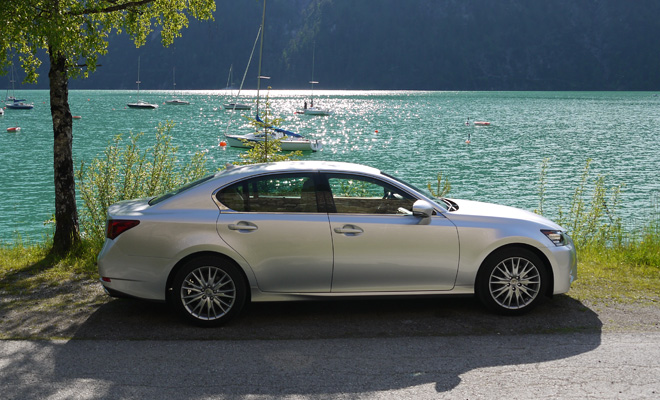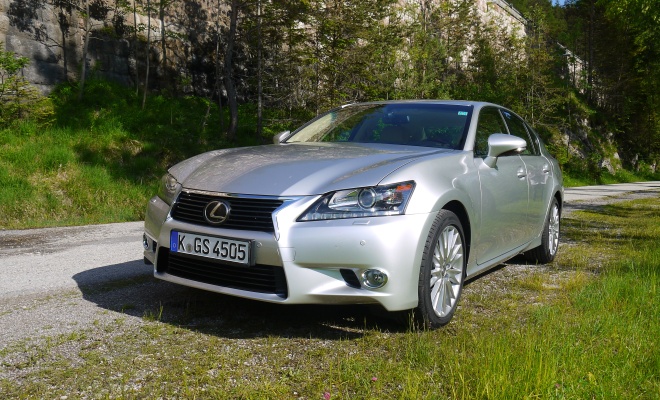by Lem Bingley 
Just over a year ago I tested the Lexus GS 450h, an appealing executive saloon with a hybrid powertrain and more than adequate amounts of poke. At the time, Lexus promised to bring a more modest version of the car to the UK in the second half of 2013. That time is now squarely upon us, and order books have finally opened for the new GS 300h. The schedule must have slipped a little as the first cars won’t arrive until January 2014.
The GS is a handsome beast and no less visually arresting for its reduced power output. It is a tad more Germanic than Japanese to the untutored eye, but is expertly put together both inside and out.

The engine room of the GS 300h houses a 2.5-litre four-cylinder petrol engine that can summon 178bhp at a fairly thrashy 6,000rpm, and a reasonable 221Nm of torque from 4,200rpm. It shares lugging duties with a 105kW (141bhp) electric motor which swells the available torque by a noticeable 300Nm. The scrabble to 62mph can be dispensed in a fleeting 9.2 seconds (though the GS 450h monsters the same sprint in just 5.9 seconds).
In compensation, the 300h boasts a yet-to-be-ratified combined-cycle fuel economy figure of 60.1mpg, a substantial improvement on the 450h’s 46.3mpg. That’s for the most modestly attired (and tyred) 300h SE edition. Graduating from its 17-inch rims to the 18s of Luxury or Premier spec cars worsens the result to 57.6mpg, while the aggressive F-Sport’s 19-inch alloys squash things down further to 56.5mpg. On the road prices range from £31,495 for the SE to £43,745 for the Premier version.

The CO2 outputs corresponding to the three wheel sizes are expected to be 109g/km, 113g/km and 115g/km, and it’s these numbers that matter most when it comes to totting up car finance, at least for the company car users who will likely be drawn to the GS 300h. For the 2013 to 2014 tax year, these bring benefit-in-kind tax rates of 13%, 14% and 15% – compared with 20% for the GS 450h. A default-choice BMW 520d SE automatic, by contrast, sits at 18% tax, partly due to its 3% penalty for supping diesel.
From April next year, all the above BIK rates will ratchet up by 1%, and then by an additional 2% the year after, bringing a low rate into sharp focus for anyone blessed (or indeed saddled) with this class of company car.
Drive is to the rear axle and, as is the case with all Lexus hybrids, the efforts of engine and electric motor are combined through a fiendish arrangement of cogs and planetary gearwheels. The result is an automatic transmission of smoothly variable ratio, divorcing the engine note from road speed in a sometimes unsettling but no doubt efficient manner.

As a result the GS 450h was not the most involving of cars to drive, but neither was it the most tiring, and the GS 300h will no doubt prove similarly effortless.
All versions of the GS 300h will arrive with a reasonable roster of features, though the entry SE trim does lack leather seats and satellite navigation. The option to add them costs a conspicuous £3,990, though it should be noted that the premium navigation screen is a panoramic 12.3-inch item and the soft leather seats are heated, ventilated and as comfortable as a duck-down duvet.
Just as the GS 300h arrives, the V6 petrol-powered GS 250 makes its exit from the UK market, never having made much of an impact – though it does serve as the lakeside model for today’s images (despite the GS 450 registration plates, that is indeed a GS 250).
If its 450h big brother is anything to go by, the new Lexus 300h should offer a tempting combination of elegance and economy, worth considering against the obvious executive options.

skip to main |
skip to sidebar
Most Popular
-
Range Rover Evoque review – eD4 and SD4 editions
-
Mercedes-Benz C 220 CDI review – Executive SE edition
-
Lexus GS 450h review
-
Rising star: Mercedes C220 BlueTec review
-
Mild-mannered hybrid: Kia Sportage 48V driven
-
Renault Scenic versus Citroen C4 Picasso
-
VW Up review – BlueMotion Technology edition
-
Audi A1 and A3 to get half an engine
Browse by Brand
Most Recent
 © 2005 to GreenMotor.co.uk | Contact | Terms & Conditions | Cookies | Privacy | Powered by
© 2005 to GreenMotor.co.uk | Contact | Terms & Conditions | Cookies | Privacy | Powered by  | Close
| Close

